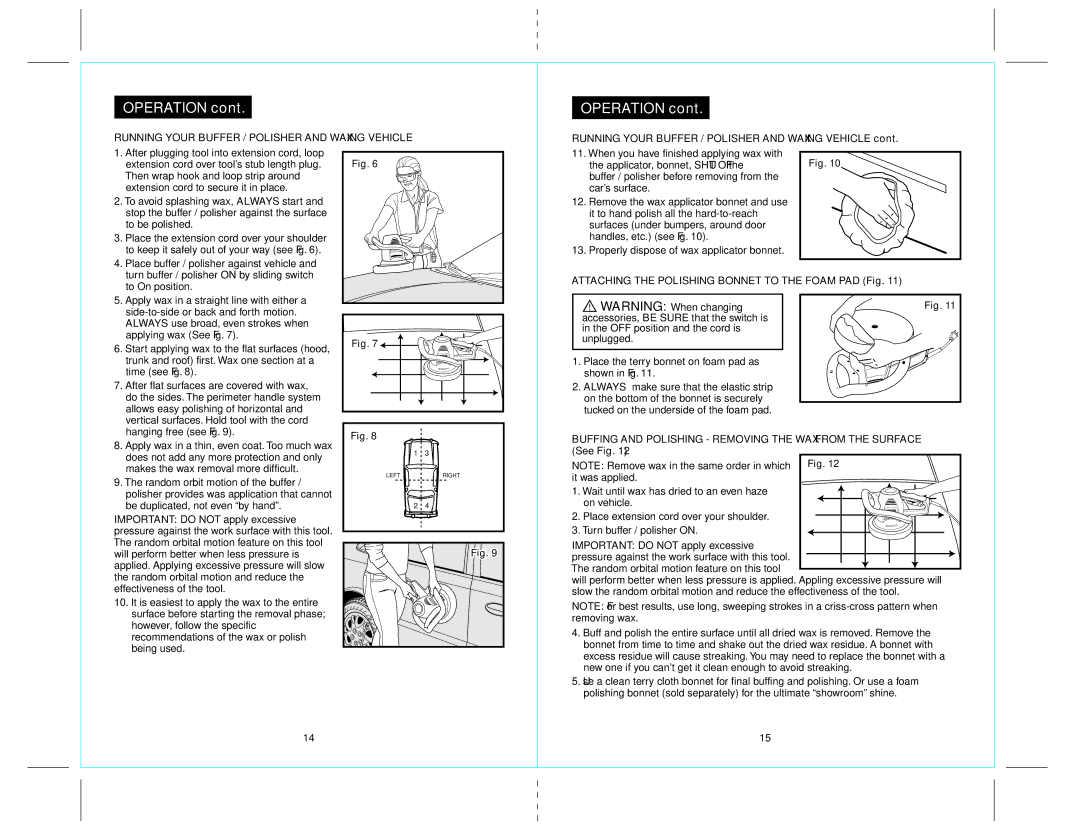
OPERATION cont.
RUNNING YOUR BUFFER / POLISHER AND WAXING VEHICLE
OPERATION cont.
RUNNING YOUR BUFFER / POLISHER AND WAXING VEHICLE cont.
1.After plugging tool into extension cord, loop extension cord over tool’s stub length plug. Then wrap hook and loop strip around extension cord to secure it in place.
2.To avoid splashing wax, ALWAYS start and stop the buffer / polisher against the surface to be polished.
3.Place the extension cord over your shoulder to keep it safely out of your way (see Fig. 6).
4.Place buffer / polisher against vehicle and turn buffer / polisher ON by sliding switch to On position.
5.Apply wax in a straight line with either a
6.Start applying wax to the flat surfaces (hood, trunk and roof) first. Wax one section at a time (see Fig. 8).
7.After flat surfaces are covered with wax, do the sides. The perimeter handle system allows easy polishing of horizontal and vertical surfaces. Hold tool with the cord hanging free (see Fig. 9).
8.Apply wax in a thin, even coat. Too much wax does not add any more protection and only makes the wax removal more difficult.
9.The random orbit motion of the buffer / polisher provides was application that cannot be duplicated, not even “by hand”.
IMPORTANT: DO NOT apply excessive pressure against the work surface with this tool. The random orbital motion feature on this tool will perform better when less pressure is applied. Applying excessive pressure will slow the random orbital motion and reduce the effectiveness of the tool.
10.It is easiest to apply the wax to the entire surface before starting the removal phase; however, follow the specific recommendations of the wax or polish being used.
Fig. 6 |
Fig. 7 |
Fig. 8
1 | 3 |
LEFT | RIGHT |
2 | 4 |
Fig. 9 |
11. When you have finished applying wax with |
| |
Fig. 10 | ||
the applicator, bonnet, SHUT OFF the | ||
buffer / polisher before removing from the |
| |
car’s surface. |
| |
12. Remove the wax applicator bonnet and use |
| |
it to hand polish all the |
| |
surfaces (under bumpers, around door |
| |
handles, etc.) (see Fig. 10). |
| |
13. Properly dispose of wax applicator bonnet. |
| |
|
|
ATTACHING THE POLISHING BONNET TO THE FOAM PAD (Fig. 11)
! WARNING: When changing | Fig. 11 |
accessories, BE SURE that the switch is |
|
in the OFF position and the cord is |
|
unplugged. |
|
1. Place the terry bonnet on foam pad as shown in Fig. 11.
2. ALWAYS make sure that the elastic strip on the bottom of the bonnet is securely tucked on the underside of the foam pad.
BUFFING AND POLISHING - REMOVING THE WAX FROM THE SURFACE (See Fig. 12)
NOTE: Remove wax in the same order in which Fig. 12 it was applied.
1. Wait until wax has dried to an even haze
on vehicle. 2. Place extension cord over your shoulder. 3. Turn buffer / polisher ON.
IMPORTANT: DO NOT apply excessive
pressure against the work surface with this tool. The random orbital motion feature on this tool
will perform better when less pressure is applied. Appling excessive pressure will slow the random orbital motion and reduce the effectiveness of the tool.
NOTE: For best results, use long, sweeping strokes in a
4.Buff and polish the entire surface until all dried wax is removed. Remove the bonnet from time to time and shake out the dried wax residue. A bonnet with excess residue will cause streaking. You may need to replace the bonnet with a new one if you can’t get it clean enough to avoid streaking.
5.Use a clean terry cloth bonnet for final buffing and polishing. Or use a foam polishing bonnet (sold separately) for the ultimate “showroom” shine.
14
15
